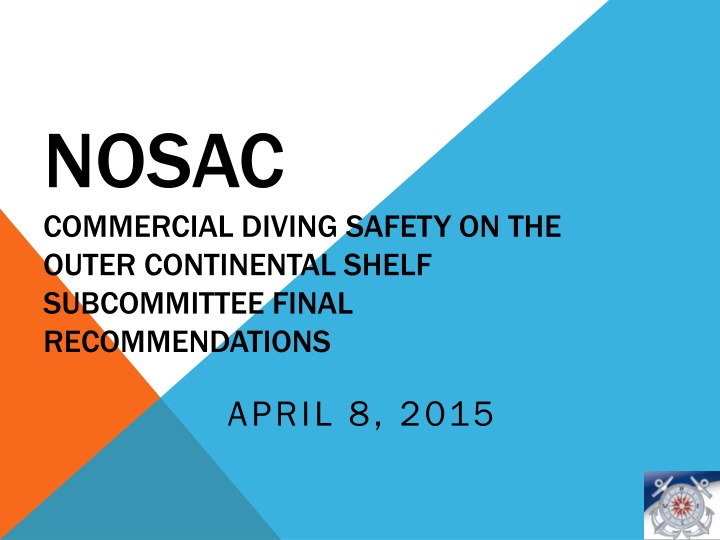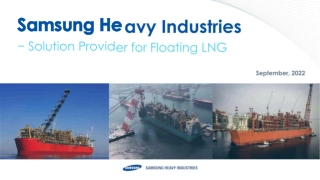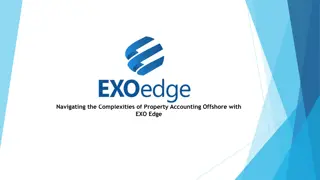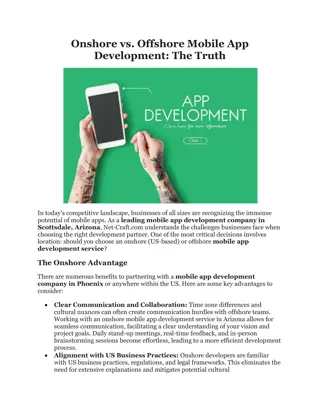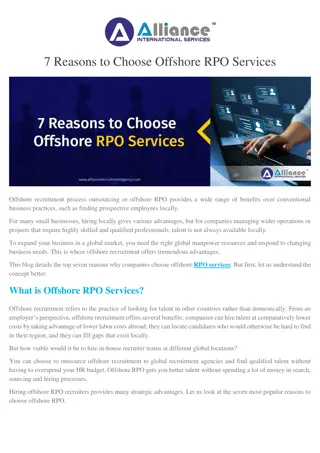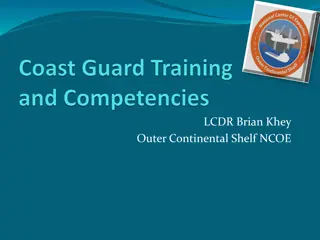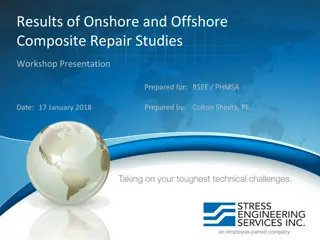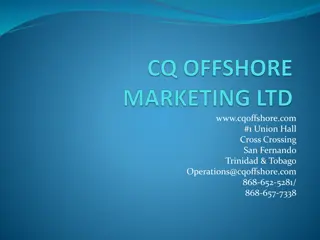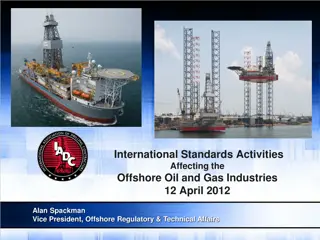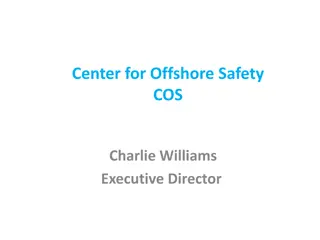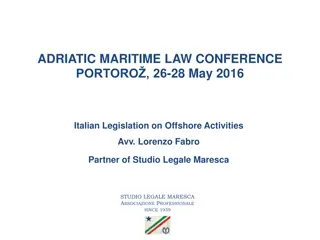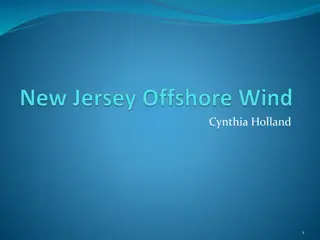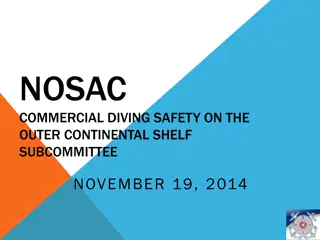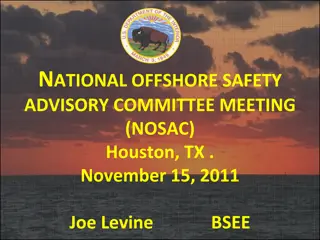Enhancing Offshore Commercial Diving Safety Recommendations
A subcommittee, formed under NOSAC, evaluated the current state of offshore commercial diving operations on the Outer Continental Shelf to improve safety standards. The focus was on addressing past commercial diving casualties and developing recommendations for the Coast Guard. Issues with consistency in regulations were highlighted, prompting a detailed analysis of industry best practices and standards. Various focus groups delved into key areas like competency, equipment, and operational procedures to enhance diving safety in challenging offshore environments.
Download Presentation

Please find below an Image/Link to download the presentation.
The content on the website is provided AS IS for your information and personal use only. It may not be sold, licensed, or shared on other websites without obtaining consent from the author.If you encounter any issues during the download, it is possible that the publisher has removed the file from their server.
You are allowed to download the files provided on this website for personal or commercial use, subject to the condition that they are used lawfully. All files are the property of their respective owners.
The content on the website is provided AS IS for your information and personal use only. It may not be sold, licensed, or shared on other websites without obtaining consent from the author.
E N D
Presentation Transcript
NOSAC COMMERCIAL DIVING SAFETY ON THE OUTER CONTINENTAL SHELF SUBCOMMITTEE FINAL RECOMMENDATIONS APRIL 8, 2015
SUB-COMMITTEE BACKGROUND A Subcommittee was formed with the appointment of: Four (4) Co-Chairs Two (2) from NOSAC Mike Brown & Kelly McClelland Two (2) from the Public Phil Newsum & Louis Schaefer Sub-committee Members Over forty (40) members from the diving community, or who work in a related industry positions
TASK STATEMENT Evaluate current state of Offshore Commercial Diving Operations on the OCS Consider Past Commercial Diving Casualties Improve Commercial Diving Operational Safety on the OCS Develop Recommendations for the Coast Guard
BACKGROUND Technological advances have made oil exploration and production in previously inaccessible locations a reality. The search for oil has moved further offshore and into deeper water; new and unique challenges have been encountered. Diver services have been an integral part of this expansion and the diving industry has adapted as well.
ISSUE Current Commercial Diving, 46 CFR Part 197, Subpart B is not consistent and current with Industry Best Practices.
SUB-COMMITTEE FOCUS GROUPS PHASE I Availability of Standards Competency/Certification DP Vessel Diving Equipment Hot Water Systems Hyperbaric Rescue Systems Live Boating (Including Manning Level Requirements) Maximum Depths Minimum Manning Levels Reserve Gas Supply Specific Diving Mode Procedures
SUB-COMMITTEE FOCUS GROUPS PHASE 2 Hyperbaric Evacuation Systems Surface Chamber Operation, and Decompression Competency Equipment Diving Systems Accountability
ROLES OF FOCUS GROUPS Actively participate Respect diverse view points Complete assigned tasks within established time periods Maintain a written record (minutes) of all group meetings or conference calls Provide updates as necessary Familiarization with the NOSAC Commercial Diving Subcommittee Task Summary Maintaining the focus of increased diving safety on the OCS when proposing revisions to 46 CFR Part 197, Subpart B
RECOMMENDATION: AVAILABILITY OF STANDARDS Finding Finding - - There are no standards for Commercial Diving Recommendation Recommendation Adoption of current: IMCA International Code of Practice for Offshore Diving Association of Diving Contractors International Consensus Standards
RECOMMENDATION: DP VESSEL DIVING Finding Finding Current CFR does not define nor address DP Diving Recommendation Recommendation Adopt the following: Definition Diving operations, surface supplied or saturation, conducted from a vessel operating in DP Mode; whenever there is any form of motive power in operation, e.g., thrusters or propellers, which automatically maintains its position (fixed or a predetermined track) by means of thruster force. The DP system consists of a power system, a thruster system, a DP-control system with the redundancy built in to maintain or restore its function, e.g. DP2 and DP3. Diving Operations conducted from a DP2 or DP3 vessel should not be considered Boatin Boating and may be performed at any time during the day or night provided a thorough hazard assessment has been performed. should not be considered Live Live- - Adopt the ADCI Consensus Standards, Section 8.0 Vessels and Floating Platforms for Diving Operations in its entirety.
RECOMMENDATION: DIVER COMPETENCY / CERTIFICATION Finding Finding - - Current CFR does not define. Recommendation Recommendation Adopt the following: Diver Qualifications Diver Qualifications - - Commercial Divers and Supervisors shall possess a recognized Commercial Diving qualification suitable for the scope of work they intend to perform unless they are engaged in a recognized training or advancement program. All personnel subject to hyperbaric exposure must possess a valid annual fitness-to- dive medical certificate.
RECOMMENDATION: DIVER COMPETENCY / CERTIFICATION (CONT D) Training Training - - A formal course of study for a Tender/Diver (entry-level) shall be completed at any accredited school, military school or equivalent whose curriculum at a minimum, conforms to current US Coast Guard recognized standards for commercial diver training. Diving personnel should follow a US Coast Guard industry recognized diver certification and training standard or matrix. In addition, other competencies or qualifications maybe required for some tasks; for example the use of specific tools or practices. The personnel included in diving personnel are: Entry-Level Tender / Diver Surface Supplied Air Diver Surface Supplied Mixed-Gas Diver Saturation Diver Surface Supplied Air-Diving Supervisor Surface Supplied Mixed-Gas Diving Supervisor Saturation-Diving Supervisor Life-Support Technician Saturation Technician
ACCOUNTABILITY PURPOSE: PURPOSE: Recommended accountability provisions for offshore Commercial diving. ISSUE: ISSUE: Currently, there are no accountability provisions in the 46 CFR Part 197, Subpart B. Duties Duties to Ensure to Ensure Compliance All commercial diving personnel shall ensure that 46 CFR Part 197, Subpart B is complied with. The commercial diving contractor and client shall ensure the diving operations includes: A full Risk Assessment, consisting of Hazard ID; Risk Assessment, and Job Safety Analysis. Is planned, managed and conducted in a manner which protects the health and safety of all persons taking part in that commercial diving defined scope of work, and complies with 46 CFR Part 197, Subpart B. All entities or individuals engaged in a diving defined scope of work, shall be authorized to issue a stop work order for the safety of those engaged in the diving defined scope of work. Compliance:
ACCOUNTABILITY (CONTD) SUPPLIES & EQUIPMENT FOR COMMERCIAL DIVING OPERATION SUPPLIES & EQUIPMENT FOR COMMERCIAL DIVING OPERATION Documentation for supplies and equipment required for commercial diving operations shall be available for inspection at the dive site location. This documentation shall include: Certificates of Compliance Log books Maintenance Records Testing Records Reporting DUTIES DUTIES OF A DIVE SUPERVISOR: OF A DIVE SUPERVISOR: The commercial diving supervisor shall be designated in writing and ensure 46 CFR Part 197, Subpart B is complied with. The designated commercial diving supervisor shall not dive during operations; unless relieved by another commercial diving supervisor qualified and designated in writing. DUTIES DUTIES OF AND QUALIFICATION FOR COMMERCIAL DIVERS: OF AND QUALIFICATION FOR COMMERCIAL DIVERS: All commercial divers shall comply with the appointed commercial dive supervisor s lawful instructions under 46 CFR Part 197, Subpart B, and be Certified and competent commercial diver. Shall have a valid annual medical fitness dive certificate. Have knowledge and understand the scope of work to be performed. Maintain a detailed and accurate record of each working dive performed.
SURFACE CHAMBER OPERATIONS & DECOMPRESSION COMPETENCY CRITERIA Purpose: Purpose: To proposed recommend competency criteria for surface chamber operations and decompression. Currently, the only language that speaks to any level of competency on this subject is in 46 CFR 197.410(8)(iii) which states: A dive team member, other than the diver, is trained and available to operate the decompression chamber; Commercial Diving Contractors shall be responsible for ensuring the designated person in charge (diving supervisor) has appropriate decompression schedules and treatment tables on site. The Contractor shall further ensure all diving personnel engaged in surface chamber operations have completed training to the American National Standards Institute (ANSI) Standard for Commercial Diver Training or industry recognized equivalent and have demonstrated competency to Contractor s Standards. Contractor shall document and retain chamber operations training and competency records for each applicable employee.
SURFACE CHAMBER OPERATIONS & DECOMPRESSION COMPETENCY CRITERIA (CONT D) Contractor s Chamber Operations competency for diving personnel engaged in surface chamber operations shall include: Operating a double-lock decompression chamber and medical lock, if installed. Setting up and breaking down of the decompression chamber using Contractor checklists and industry-recognized documentation. Selecting, following, and charting appropriate decompression tables and schedules. Demonstrating knowledge of the signs, symptoms, and treatments for diving-related injuries. Selecting and following appropriate flowcharts, treatment tables and schedules for diving-related injuries. Demonstrating knowledge of hyperbaric safety precautions and sanitation procedures. Demonstrating knowledge of safe and proper handling of oxygen and oxygen delivery equipment. Tending a diver inside a decompression chamber.
RECOMMENDATION EQUIPMENT: HOT WATER SYSTEMS Finding Finding - - Current CFR does not define. Recommendation Recommendation Adopt the following.: A suit receiving hot water must have a diver-operated bypass valve at the umbilical to divert excessively hot water. The source of a hot water system must be constructed so that the volume of controlled-temperature hot water supplied to the diver allows sufficient time for the diver to complete the environmental exposure portion of the dive. An adequate thermal support system must be in place to provide an amount of protection time equal to the bailout breathing gas supply time. A hot water system volume tank must be large enough to diffuse a sudden change in water temperature from reaching the diver. The water temperaturedelivery system must changeslow enough to allow for evasive action should the water supply temperature become detrimental to the diver s health. Hot water shall have audio and visual temperature alarms.
RECOMMENDATION EQUIPMENT: DIVING SYSTEMS Finding Finding - - CFR is not consistent and current with industry best practices. Recommendation Recommendation Define and adopt the following.: Surface supplied air diving (0 Surface supplied air diving (0 35 ) Decommission chamber required Surface supplied deep air diving (36 Surface supplied deep air diving (36 - -165 ) Surface mixed gas diving (HeO2) (120 Surface mixed gas diving (HeO2) (120 250 ) Surface supplied nitrogen/oxygen mixed gas diving Surface supplied nitrogen/oxygen mixed gas diving 35 ) 165 ) 250 )
RECOMMENDATION: HYPERBARIC EVACUATION SYSTEM Finding Finding - - Current CFR does not define or address. Recommendation Recommendation Adopt the following: There shall be a Hyperbaric Evacuation Facility on site when performing Saturation Diving Operations. Adopt the IMCA Standard for Hyperbaric Evacuation Facility of Saturation Divers. Shall have a transportable means (Flyway Package) to support the environmental and gas requirement of the Hyperbaric Evacuation Facility during decompression. There shall be a written Emergency Hyperbaric Evacuation Plan on site.
RECOMMENDATION: HYPERBARIC EVACUATION SYSTEM Finding Finding - - Current CFR does not define or address. Recommendation Recommendation Adopt the following: HRC required Is not the primary diving bell Minimum 72 hours breathing gas Dedicated life support package Within 24 hours Is not float off or crane dependent launch style Hyperbaric Evacuation Plan Required Risk Assessed Drills Regular drills Frequency Components Safe Haven Hyperbaric Recue Facility Decompression in place
RECOMMENDATION: LIVE BOATING INCLUDING MANNING REQUIREMENTS Finding Finding Current CFR is not consistent and current with Industry Best Practices. Current CFR is not consistent and current with Industry Best Practices. Recommendation Recommendation Adopt the following: Adopt the following: Definition Live Boating is a diving technique where a single surface supplied diver performs work underwater while the diver s umbilical is being tended from the bow of a vessel which is manually operated by the vessel master and underway using its primary propulsion system. During live boating operations, the Person in Charge shall be experienced in live boating operations and familiar with the scope of work, as well as the depth and duration of the dive; The Person in Charge shall ensure that Diving is not conducted in seas that impede station-keeping ability of the vessel; Live boating operations are not conducted (i) in other than daylight hours; or (ii) During periods of restricted visibility; The primary propulsion system of the vessel is stopped before the Diver enters or exits the water; and A boat is ready to be launched with the crew in the event of an emergency; and The diving crew shall consist of a minimum of seven (7) diving qualified personnel. One (1) Dive Supervisor One (1) Diver One (1) Standby Diver Two (2) Tender / Divers Two (2) personnel that are qualified Divers to assist with rescue boat operations.
RECOMMENDATION: LIVE BOATING INCLUDING MANNING REQUIREMENTS (CONT D) Restricted visibility means any condition in which vessel navigational ability is restricted by fog, mist, falling snow, heavy rainstorms, sandstorms, lack of daylight, sea states that disturb the water surface and impede the ability to visually see the Diver s bubble location, or any other similar causes. During live boating operations, the Diving Supervisor must be experienced and knowledgeable in live boating operations and the Diving Supervisor shall ensure that diving is not conducted at depths greater than 130 FSW; Diving is not conducted in seas that impede Diver mobility or work function including water currents that impede Diver mobility; In addition to the Tender / Diver, an additional mechanical device is required to ensure that the Diver's umbilical does not become entangled in the vessel's propeller(s) or primary propulsion system; A Standby Diver is ready, available and appropriately dressed while a Diver is in the water; Diving is not conducted with in-water decompression obligations; and
RECOMMENDATION: LIVE BOATING INCLUDING MANNING REQUIREMENTS (CONT D) The Person-In-Charge is notified before a Diver enters or exits the water. During live boating operations, the minimum equipment shall consist of Surface supplied diving equipment that is adequate for the depth of water; A third diving umbilical connected to the manifold for emergency use; Hard wired communications are utilized between the Diver and Dive Supervisor; A diver worn reserve gas supply with a 5 minute breathing duration at depth; A method of clear communications between the vessel master and the Dive Supervisor, A method of clear communications between the Dive Supervisor and the Tender / Diver; An emergency shutdown device for the main propulsion system; A mechanical device to prevent dive umbilical entanglement in the primary propulsion system; and A means to provide a stable platform for the Diver for in-water decompression for emergency purposes.
RECOMMENDATION MANNING LEVELS: SURFACE SUPPLIED AIR DIVING Finding Finding - - Current CFR is not consistent and current with Industry Best Practices Recommendation Recommendation Adopt the following: Scuba Diving not recommended for Commercial Diving Operations. SURFACE SUPPLIED-SHALLOW AIR DIVING Shallow air diving to be conducted in depths from 0 35 feet. No planned decompression. Minimum manning levels The minimum personal to conduct surface supplied-shallow air diving operations is five (5), with the following requirements; One (1) Diving Supervisor Must be a designated, qualified, Non-Diving Supervisor who is not required or allowed to dive, and has the qualifications of Surface Air Dive Supervisor; whose main responsibility is to ensure the safety of the Divers; Two (2) Divers Qualified for the type of work being conducted; Two (2) Tender / Divers Each Diver is to be continuously tended while in the water. When a Diver is in a physically confined space another Diver is stationed at the underwater point of entry and is line tending the Diver. This would require one (1) additional Diver and on additional Tender / Diver to be on the job.
RECOMMENDATION MANNING LEVELS: SURFACE SUPPLIED DEEP AIR DIVING Finding Finding - - Current CFR is not consistent and current with Industry Best Practices Recommendation Recommendation Adopt the following: SURFACE SUPPLIED-DEEP AIR DIVING Deep air diving to be conducted in depths from 34 165 feet. Minimum 1 double lock decompression chamber. Minimum manning levels The minimum personal to conduct surface supplied-deep air diving operations is five (5), with the following requirements; One (1) Diving Supervisor Must be a designated, qualified, Non-Diving Supervisor who is not required or allowed to dive, and has the qualifications of Surface Air Dive Supervisor; whose main responsibility is to ensure the safety of the Divers; Two (2) Divers Qualified for the type of work being conducted; Two (2) Tender / Divers Qualified to operate decompression chamber Each Diver is to be continuously tended while in the water. When a Diver is in a physically confined space another Diver is stationed at the underwater point of entry and is line tending the Diver. This would require one (1) additional Diver and one (1) additional Tender / Diver to be on the job.
RECOMMENDATION MANNING LEVELS: SURFACE SUPPLIED MIXED-GAS DIVING (HEO2) Finding Finding Current CFR is not consistent and current with Industry Best Practices Recommendation Recommendation Adopt the following: Minimum manning levels The minimum personal to conduct Surface Supplied-Deep Air Diving Operations is six (6), with the following requirements; One (1) Diving Supervisor Must be a designated, qualified, Non-Diving Supervisor who is not required or allowed to dive, and has the qualifications of Surface Supplied Mixed-Gas Diver Supervisor; whose main responsibility is to ensure the safety of the Divers; One (1) Mixed-Gas Manifold Operator (Rack Operator); Must be a designated qualified Non-Diving, Gas Manifold Operator/Life Support Technician, who is not required or allowed to dive. Whose two main responsibilities are to insure that the proper gas mixtures are supplied to the Diver and all in water decompression is properly completed; Two (2) Divers Qualified for the type of work being conducted; Two (2) Tenders / Divers Qualified to operate decompression chamber Each diver is to be continuously tended while in the water. When a Diver is in a physically confined space another Diver is stationed at the underwater point of entry and is line tending the Diver. This would require one (1) additional Diver and one (1) additional Tender / Diver to be on the job.
RECOMMENDATION MANNING LEVELS: SURFACE SUPPLIED MIXED-GAS DIVING (HEO2) Finding Finding Current CFR is not consistent and current with Industry Best Practices Recommendation Recommendation Adopt the following: : Minimum manning levels The minimum personal to conduct Surface Supplied-Deep Air Diving Operations is six (6), with the following requirements; One (1) Diving Supervisor Must be a designated, qualified, Non-Diving Supervisor who is not required or allowed to dive, and has the qualifications of Surface Supplied Mixed-Gas Diver Supervisor; whose main responsibility is to ensure the safety of the Divers; One (1) Mixed-Gas manifold operator (Rack Operator); Must be a designated qualified Non-Diving, Gas Manifold Operator/Life Support Technician, who is not required or allowed to dive. Whose two main responsibilities are to insure that the proper gas mixtures are supplied to the Diver and all in water decompression is properly completed; Two (2) Divers Qualified for the type of work being conducted; Two (2) Tenders / Divers Qualified to operate decompression chamber Each Diver is to be continuously tended while in the water. When a Diver is in a physically confined space another Diver is stationed at the underwater point of entry and is line tending the Diver. This would require one (1) additional Diver and one (1) additional Tender / Diver to be on the job.
RECOMMENDATION MANNING LEVELS: SURFACE SUPPLIED NITROGEN/OXYGEN MIXED-GAS DIVING Finding Finding Current CFR does not contain Surface Supplied Nitrogen/Oxygen Mixed-Gas Diving Guidelines Recommendation Recommendation Adopt the following: Minimum manning levels The minimum personal to conduct Surface Supplied-Deep Air Diving operations is five (5), with the following requirements; One (1) Diving Supervisor Must be a designated, qualified, Non-Diving Supervisor who is not required or allowed to dive, and has the qualifications of Surface Supplied Mixed-Gas Diver Supervisor; whose main responsibility is to ensure the safety of the Divers; Two (2) Divers Qualified for the type of work being conducted; Two (2) Tenders / Divers Qualified to operate decompression chamber Each Diver is to be continuously tended while in the water. When a Diver is in a physically confined space another Diver is stationed at the underwater point of entry and is line tending the Diver. This would require one (1) additional Diver and one (1) additional Tender Diver to be on the job.
RECOMMENDATION: MAXIMUM DEPTH Finding Finding Current CFR is not consistent and current with Industry Best Practices Recommendation Recommendation - - Adopt the following: Scuba Scuba Diving (Not Recommended for Commercial Diving Operations) Diving (Not Recommended for Commercial Diving Operations) 30 FSW (It should be restricted to 30 FSW for minor shallow inspection applications.) Surface Supplied Air Diving Surface Supplied Air Diving 165 FSW Surface Supplied Mixed Surface Supplied Mixed- -Gas ( Gas (HeO HeO ) Diving ) Diving 250 FSW (Requirement for an open bottom bell with onboard emergency gas for all HeO diving applications) Surface Supplied NITROX (N Surface Supplied NITROX (N O O ) Diving ) Diving Maximum 1.3 PPO Saturation Diving Saturation Diving No limits
RECOMMENDATION: RESERVED GAS SUPPLY (BAILOUT BOTTLE OR RGS) Finding Finding Current CFR is not consistent and current with Industry Best Practices and does not require RGS in less than 130 FSW. Recommendation Recommendation - - Adopt the following: Require Reserved Gas Supply on all dives. Must be able to supply a minimum of five (5) minutes breathing supply to the Diver at depth. RGS must contain the same gas as the Divers Bottom Mix.
RECOMMENDATION: SPECIFIC DIVING MODE GUIDELINES Finding Finding Current CFR does not contain Saturation Diving Guidelines. Recommendation Recommendation - - Add Saturation Diving Guidelines: Recommend CFR should include specific requirements for Saturation Diving. Propose draft text on Saturation Diving for inclusion in the CFR, as follows: The Diving Supervisor shall insure that When Saturation Diving is conducted, a suitable living habitat is present for Divers to live. The living habitat shall consist of shower, sleeping, eating and the toilet receptacle with a raised vented seat to ensure a seal cannot be created. A closed bell with Transfer Under Pressure (TUP) capacity is available. Each bell shall have two forms of retrieval in the event of a parted lifting or malfunctioning apparatus. A hyperbaric rescue facility, Self Propelled Hyperbaric Life Boat (SPHLB), or Hyperbaric Rescue Chamber (HRC), shall be available which is capable of evacuating the Divers and attaining the maximum storage depth of the Saturation Dive. Additionally, dive supervisors must ensure an evacuation plan is in place to take into account available recompression facilities to safely ascend divers following any incident.
RECOMMENDATION: SPECIFIC DIVING MODE GUIDELINES (CONT D) The Diving Supervisor shall insure that (Cont d) A Standby Diver is available when the closed bell leaves the dive location until the Divers have returned to the Saturation System. A qualified dive team member shall be available at the dive location to assist in the recovery of the closed bell or its occupants. Follow the established Dive Plan Procedure for obtaining medical support in the event of an accident, either for a diving or non-diving related incident. Ensure a DMT / EMT is present and available. Validate the Dive Plan for sufficient Breathing Mixtures, Supplies, and Equipment. Verify that all personnel meet the necessary qualification to perform the assigned task.
RECOMMENDATION: SPECIFIC DIVING MODE GUIDELINES (CONT D) The Diving Supervisor shall insure that (Cont d) A Standby Diver is available when the closed bell leaves the dive location until the Divers have returned to the Saturation Facility. There should be a Dive Intervention Plan in place. There shall be a suitable supply of treatment gas available for each individual storage depth of the Saturation System. Each diving operation shall have a primary and secondary breathing gas supply meeting the proposed established requirements. The lockout duration from seal to seal shall take into consideration fatigue, physiological effects, including type of work being undertaken.
ADDITIONAL RECOMMENDATIONS Jurisdiction Jurisdiction In addition to the accountability provisions proposed above, we respectfully submit for consideration the consolidation of investigations of incidents through the United States Coast Guard. And, propose the following language: The Coast Guard shall be responsible for the investigation of all incidents, related to injuries, deaths or violations of CFRs, occurring on all navigable waterways, as a result of a diving defined scope of work. Incident Database Incident Database The United States Coast Guard create an accessible online database of all records relating to any diving injuries, deaths and/or violations of the CFRs, occurring on all navigable waterways, as a result of a diving defined scope of work.
ADDITIONAL RECOMMENDATIONS (CONTD) Variance Variance Request Request Issue: Under 46 CFR 197.206, Substitute for required equipment materials apparatus, arrangement, procedures, or test) there is no clear process Recommendation: The variance request time requires takes several days to weeks for review and approval. Unclear to which USCG office to route a variance request. Unclear of format and information required for submittal of variance.
THANKS TO THE PHASE 2 FOCUS GROUP FACILITATORS Group 1 Group 1 Kevin Lord Group 2 Group 2 Travis Detke Travis Detke Group 3 Group 3 John Roat John Roat Group 4 Group 4 Limor Ben Maier Limor Ben Maier Kevin Lord
PROCESS FOR ADDITIONAL PUBLIC COMMENTS Comments on the newly released USCG Comments on the newly released USCG Notice of Proposed Rule Making (NPRM) Notice of Proposed Rule Making (NPRM) for Commercial Diving will be submitted for Commercial Diving will be submitted independently by industry stakeholders. independently by industry stakeholders. For further information contact For further information contact ken.a.smith@uscg.mil ken.a.smith@uscg.mil
